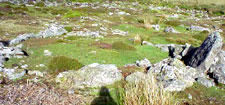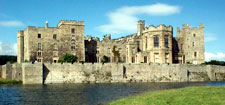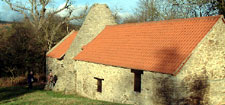Cultural Heritage
The landscape we see today has been shaped over thousands of years by the activities of people. Many of the things they made, like hedges and walls, buildings, roads and paths, are still in use today. Others, like barrows and stone circles or abandoned mines and quarries, survive as relics in the modern countryside or lie buried beneath its surface.
Less obvious legacies of our past are the plant communities of habitats like old meadows and pastures, moors, heaths and ancient woodlands that have evolved over centuries of interaction between people and their environment.
The landscape is a cultural artefact, a living record of the activities of our ancestors. It provides evidence of, and insight into, our past. This ‘time-depth’ is for many people an important point of connection with the landscape and yet it is not always well understood.
Most landscapes in the county contain features surviving from many periods of their history but some are strongly influenced by features developed in particular development phases. The difference in character between the planned enclosure landscapes of the upland fringes with their regular grids of fields and straight roads, and the irregular enclosures of the lowlands with their winding lanes and old villages is directly related to their history. The character of the landscape is affected by both these landscape scale patterns of interrelated elements and by the smaller idiosyncratic features that contribute so much to local character and ‘sense of place’.
All landscapes contain an historic dimension and all are evolving in some degree as we adapt them to meet our changing needs. Historic landscape features and archaeological features are continuously threatened by forces ranging from development to neglect, natural decay or changes in management. The challenge is to understand the historic features that surround us and to conserve what we value most while allowing the landscape to continue to evolve.
Understanding the Historic Landscape
A considerable amount of information already exists about the archaeology and built heritage of the county. The County Durham Sites and Monuments Record (now know as the Historic Environment Record) contains thousands of records ranging from flint scatters to industrial buildings. It can now be accessed online through the County Council website or, with the added facility of internet mapping, through the Keys to the Past website.
The County Durham and Darlington Historic Landscape Character Assessment (HLCA) (now know as the Historic landscape characterisation ) is currently being carried out with the support of English Heritage. This will map, analyse and identify the origins of man made features, and particularly field systems, across the county. It will provide a very detailed account of the history of the Durham landscape and a basis for future programmes of conservation and interpretation. It is anticipated that the HLCA will be completed in 2012.
Conserving the Historic Environment
Conserving the historic environment requires a combination of statutory protection for nationally important sites and buildings, the protection of historic landscapes and significant archaeological or landscape features from the impacts of development, and the positive management of valued sites and features.
The county’s most important sites have statutory protection as Scheduled Ancient Monuments (SAM) or as Listed Buildings or Conservation Areas. Listed buildings include many landscape features like old mine entrances, sheepfolds and boundary posts. Conservation Areas often include parts of the landscape setting of important townscapes as well as historic landscapes like designed parklands. Durham Castle and Cathedral are designated by UNESCO as a World Heritage Site.
Historic field boundaries are protected by the Hedgerow Regulations 1997. The County Durham Structure Plan and District Wide Local Plans contain policies for the protection of features of importance to our cultural heritage from the impacts of development. A number of historic parklands are identified on English Heritage’s Register of Parks and Gardens of National Importance. Other locally important parklands are identified in local plans. Some if these are the subject of local planning policies or have Conservation Area status.
There are a number of existing initiatives aimed at conserving or restoring historic landscapes or landscape features. The Historic Grant Scheme provides funding for conservation works to buildings in Conservation Areas and a Repairs Grant is available in some circumstances for works to listed buildings. The County Durham Hedgerow Partnership Field Boundary Restoration Grant is available for the restoration of historic hedges. Some of the existing agri-environment schemes and their successor Environmental Stewardship give financial support for conserving archaeological and historic landscape features.
There have been a wide range of local authority initiatives to conserve or restore historic landscapes or buildings, including the current Hardwick Park Restoration Project supported by the Heritage Lottery Fund. The North Pennines AONB Management Plan contains a broad range of proposals for conserving and interpreting the historic environment. Voluntary sector organisations such as the North Pennines Heritage Trust are also very active in this field.
Despite these initiatives many historic landscape features remain vulnerable to damage from development, or to the less obvious processes of neglect and decay. This is particularly the case for many widespread features like old hedges, walls and sheepfolds, old lanes and tracks, earthworks like lynchets and rig and furrow, relic features like coal and lead mining remains and designed parklands.
Interpreting the Historic Environment
While there may be some merit in conserving historic landscape features for their own sake, their real value lies in their meaning to us as part of our cultural heritage.
Raising public awareness of the historic landscape, and making sites and landscapes accessible and intelligible to people is therefore a key element in their conservation.
Objectives
- To promote awareness, understanding and enjoyment of the historic dimension of landscape character in County Durham.
- To support the development of the County Durham Historic Landscape Character Assessment.
- To promote the conservation of historic landscapes and landscape features.



